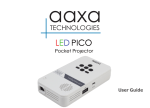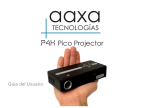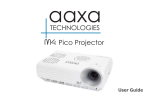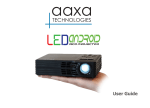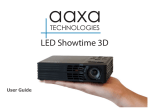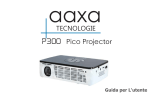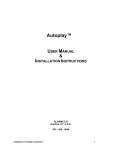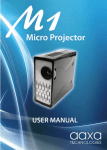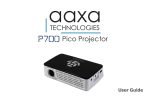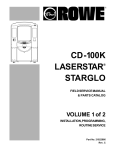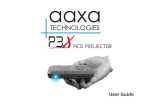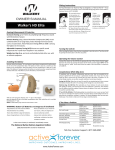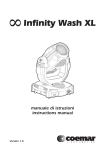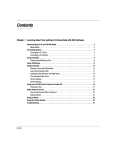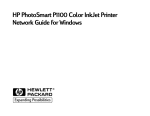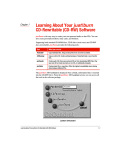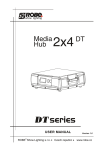Download P4 User Manual - AAXA Technologies
Transcript
aaxa TECHNOLOGIES P4 Pico Projector User Guide Caution! WARNING: Please use this product as instructed. Misuse may cause injury or death. DO NOT use while driving DO NOT expose to water or wet surfaces. Electric shock may occur DO NOT expose the LED to your eyes or the eyes of others DO NOT block or restrict airflow from ventilation holes as this may cause the projector to overheat Keep the projector, battery, or charger away from any heat sources Caution for Battery Use • • • Do not pierce or puncture the battery with sharp objects Do not heat the product or expose it to high temperature. Do not wet it or place it in any liquid Caution for Earphone (Earplug) Use • • Prolonged use at high volume may impair your hearing. High volume during walking or driving may cause distractions and result in injury or death The AAXA P4 runs the Windows CE operating system. All Standard Functions can be found on the Home Screen and can be manipulated with the keypad on the projector. Because we dislike locked devices, rather than locking the Windows CE Desktop we have decided to leave this function unlocked. This allows users to enjoy the full capabilities of the Windows CE operating system. However if you choose to access the desktop, please make sure you know what you are doing. It is very easy to damage or corrupt the projector or the operating system through the Windows Desktop. AAXA does not support 3rd party applications and any adjustments to the desktop. You are on your own here – please access the Windows Desktop at your own risk. Windows CE Desktop Notice: Accessing the desktop allows the user to manipulate the file system including installation of applications and manipulation of the OS control panel. Improper use can result in corruption and/or damage to the Operating System. AAXA Technologies does NOT provide technical support for Operating System issues. ACCESS AT YOUR OWN RISK! Use of desktop requires a mouse and keyboard. Please visit our webpage for more information Table of Contents 2 Chapter 1: P4 at a glance 2 Main Unit Front/Back 3 Remote & Keypad 4 Accessories 5 Chapter 2: Getting Started 5 Powering On / FF 6 Focus Adjustment / Throw Distance 7 External Inputs /Input Sources 8 Connecting to a Computer 10 Connecting to Composite Video 12 Connecting to Speaker or Headphones 13 Connecting to Mouse/Keyboard 15 Computer Data Transfer 17 Saving to USB/SD card 18 Connecting a Micro SD Card 19 Connecting to a USB drive 20 Chapter 3: Menu Screens 20 Main menu 21 Video Player Menu 23 Photo Viewer Menu 25 Music Player Menu 27 Windows CE Desktop 28 Setup Menu 29 Chapter 4: Technical Details 29 Troubleshooting 31 Specifications 1 P4 at a Glance Main Unit Front/Back/Side Chapter 1 Back Button Power Button Confirm Selection Reset Hole Micro SD Card Port Focus Adjustment Projection Lens Directional Pad Charge Indicator USB Port Mini USB Port Power Input VGA Input A/V Input Headphone 2 Remote & Keypad Power On/Off Main Menu Navigation Select Source Media Player Menu Navigation Power Direction Pad Exit/Back Both the keypad and remote can be used to navigate through the menus. The Main Menu Navigation on the remote functions exactly the same as the directional pad on the P4 unit. NOTICE: Pressing power on the remote will only put the projector in STANDBY mode. Please press the power button on the projector if you want to turn it off. 3 Accessories Tripod Power Adapter Remote Mini USB to USB Adapter Optional Keyboard/Mouse VGA Cable A/V Cable *Under various circumstances, the actual accessories may be different from those shown in the pictures above. 4 Getting Started Chapter 2 Powering ON the projector 1. Connect the power cord to the P4. 2. Connect the wall plug into the wall power source. 3. Press POWER button and hold for 2-3 seconds to switch on or switch off the power • The LED turns red while charging. • The LED turns green when charging is finished. • 4 hours of charge time is required to reach a full charge. Powering OFF the projector 1. Press and hold the power button for 3 seconds. 2. The optical engine should power off and the fan should stop spinning. • Note. Pressing the power button on the remote puts the projector in standby mode. It will NOT turn off the projector. Note: The P4 Projector battery does not charge when it is in operation. 5 Focus Adjusment / Throw Distance Focus Adjustment 1. Spin the focus wheel left of right until the image becomes clear. 2. The recommended focus distance for this projector is 12” to infinity. Throw Distance Chart Distance inch (“) 12 18 24 30 36 74 84 96 Diagonal Inch (“) 6.3 9.5 12.6 15.8 18.9 38.9 44.2 50.5 DIA GO NA LS CR EE NS IZE 16:9 Aspect Ratio Throw Ratio 1.9 *minimum throw distance: 10 inches 6 External Inputs/Outputs Micro SD Card Headphone/speaker Keyboard Composite Cable USB Stick Laptop Desktop Mouse 7 Connecting to a Computer Step 1: Connect the large end of the to your computer’s VGA Cord Step 2: to your P4’s Connect the small end of the Step 3: VGA Adapter VGA Cord VGA Adapter In the Main Menu Then Select “Source” Change resolution 8 Connecting to a Computer Cont. Step 4: Enabling VGA output on your Computer – To enable VGA output on your computer most computers require “turning on” the video output feature. Each computer is different. Please consult your owner’s manual for instructions to enable VGA output. Below are standard instructions for a Windows XP computer – not all systems are the same. Step 5: Press function & “F5” to instruct the computer to enable multiple displays. You can also press Windows+P to toggle through display settings. *NOTE: different operating systems may differ Step 6: 1.Right click on computer desktop and select “Properties” 2.Display Properties window will pop up 3.Click on the “Settings” Tab 4.If a secondary monitor is grayed out, click on it and check “Extend my Windows Desktop onto this monitor” 5.If the image is blurry or the text is not legible, adjust the screen resolution. We recommend 800x600 or 1024x768. 9 Connecting to Composite Video Step 1: Connect one end of the to your P4’s Composite Cord A/V Adapter Step 2: Connect opposite end of to your devices Composite Cord Composite Cord 10 Connecting to Composite Video Cont. Step 3: In the Main Menu Then Select “Source” Choose Composite Video Step 4: Turn on your multimedia device. Connectivity with multimedia devices The P4 can connect to many media devices including: iPod, iPhone, iPad, VHS players, DVD players, smart phones, cameras, video game consoles and other peripherals with ease. *Apps on smart phones require video out capabilities to be displayed with the P4. 11 Connecting Speakers/Headphones Step 1: Connect your speaker to your P4’s or headphones 3.5 mm cord Speaker Adapter Step 2: Ensure the power and volume on your speaker or headphones is turned on Step 3: Place headphones/earphones in/over ears Caution for Earphone (Earplug) Use • Prolonged use at high volume may impair your hearing. 12 Connecting Keyboard/Mouse Step 1: Remove the USB Adapter from the back of your Keyboard /mouse combo Step 2: Connect your keyboard/mouse combo’s to your P4’s USB Adapter USB Input Step 3: Move the ON/Off Switch on the side of the combo. Step 4: Press the “red” button to sync the wireless usb adapter to the keyboard. Mouse Touchpad Left Click Right Click 13 Connecting Keyboard/Mouse Optional Keyboard and Mouse can be purchased directly from AAXA Technologies at www.aaxatech.com A USB mouse can be used to select most options on the P4. • To move the cursor, place 1 finger on the pad located on the right and move your finger in the direction you wish to move the mouse. • Hover over your selection and click the left mouse button. • A keyboard can be used in the “desktop” feature. Please refer to the “Desktop section of the manual for a more detailed explanation. Wireless Signal 14 Computer Data Transfer Only Step 1: Connect small end of the Step 2: to your P4’s USB Adapter Connect opposite end of Micro USB Input to your computer’s USB Adapter USB Port Connecting your P4 to your computer for data transfer allows you to add files to store onto the onboard memory. This will allow you to play files with your P4 as a standalone device. 15 Computer Data Transfer Only Step 3: Turn On the P4 and open the OR “Open to view files” that autoplays. NAND hardrive Step 4: Place files in appropriate folders Image files go here Video files go here Music files go here Note. If your computer fails to detect the projector, check to make sure the cable is securely inserted on both sides. If you’re still unable to view the folder, please consult with your operating system’s owner manual. 16 How to Save Files to your Sd or USB In order to correctly display your media files SD or USB, the files must be placed in the correct folder. Step 1: Create folders “movie”, “music”, and “picture” in all lowercase. To do this, right click on your mouse on an empty space in your SD or USB’s main folder. Step 2: Place files in appropriate folders Video files go here Music files go here Image files go here 17 Micro SD Card How to insert your Micro SD Card • Slide in your SD card into the SD card slot on the front of the P4. (as shown in picture) • Gently slide the SD card until it *clicks* into place. How to access your Micro SD Card • Once your SD card has been inserted, you can navigate through the main menu to select what you want to view under each sub menu.(Videos, Photo, Music) • After selecting SD card mode you should now be able to access the data on the SD device through the onboard media player. *Review the Specification section of this manual to read about the supported file formats. 18 USB OTG(On-the-Go) How to insert your USB Drive • Slide your USB Drive into USB slot. (as shown in picture) • Gently slide the drive until it cannot go in any further. How to access your USB Drive • Once your USB Drive has been inserted, you can navigate through the main menu to select what you want to view under each sub menu.(Videos, Photo, Music) • After selecting USB Drive Mode you should now be able to access the data on the USB drive through the onboard media player. *Review the Specification section of this manual to read about the supported file formats. 19 Menu Screens Chapter 3 Main Menu The P4 features a built in PMP (Portable Media Player) function. This function allows the projector to play videos, pictures, music files, and text. To access the main menu simply turn on the projector. • • • Scroll Left/Right by pressing the rewind/fast foward buttons To select a submenu, highlight the desired submenu and press the Play/Pause button located in the middle of the keypad or remote. To go back to the previous page while in a submenu, press the back on the far right just underneath the directional keypad. 20 Video Player Menu Rewind / Back Pause Play/Stop Fast-Foward / Next Open File Volume Down Volume Up Opening a file: • Choose “Open File” option • Select device file is stored on • Select file from list 21 Video Player Menu Playing Videos To play/pause a video, press the play button in the middle of the keypad or remote control To rewind, press and hold the left arrow button To fast-forward, press and hold the right arrow button To jump forward to the next vide, press the right arrow button To jump back to a prior video, press the left arrow button To adjust the volume, press the vol+ (on the remote) to increase and vol- (on the remote) to decrease the volume Note: If the video is large, please allow the projector a moment to process the file. If after a few minutes the projector does not play a video, it means the file is not compatible. *Review Specification section of this manual for supported video formats. 22 Photo Menu Close Menu Previous Next Run Slideshow -1 sec to slideshow +1 sec to slideshow Open File Opening a file: • Choose “Open File” option • Select device file is stored on • Select file from list 23 Photo Menu Viewing Pictures The P4 Pico Projector allows you to view pictures individually or in a slideshow. To view individual photos, select the file you want to view in the file menu for the particular storage device on which the image file is stored. You can press the left and right arrow buttons on the touch pad or remote to flip through the pictures you have in the present folder. Viewing Pictures in a Slideshow To view your pictures in a slideshow, select a file and press Play when the picture appears. *Review Specification section of this manual for supported picture formats. 24 Music Player Menu Previous Play Stop Next Open File Repeat Shuffle Playlist Volume up Volume down Opening a file: • Choose “Open File” option • Select device file is stored on • Select file from list 25 Music Player Menu Listening to music To play/pause a song, press the play button in the middle of the keypad or remote control To rewind, press and hold the left arrow button To fast-forward, press and hold the right arrow button To jump forward to the next vide, press the right arrow button To jump back to a prior video, press the left arrow button To adjust the volume, press the vol+ ( on the remote) to increase and vol- ( on the remote) to decrease the volume *Review Specification section of this manual for supported video formats. 26 The Windows CE Desktop allows users to load, install, and manipulate any third party applications that are supported by Windows CE including word processing, spreadsheets, games, and other applications. A Keyboard and Mouse is REQUIRED to use the Windows CE Desktop NOTE: To Exit Desktop mode, double click the button located on the desktop! Technical Support for the Desktop is not available. Please direct any questions to aaxatech. forumotion.com and we will do our best to assist you. 27 Setup Menu The Settings Menu can be accessed by selecting “Settings”on the main menu Sound & Display Volume Settings • Allows the raising or lowering of volume Picture Adjustment • Brightness, backlight and color temperature options IMAGE FLIP • Flips image upside down (for rear projection) Date and Time • Adjust Date and Time • The projector allows you to choose from different languages To choose the language of your choice, highlight the language you want and press play. Language & Keyboard There are 4 menus in the settings menu • Disk Usage • Displays total memory used on the P4’s onboard memory as well as an SD card if inserted 28 Chapter 4 Technical Details Troubleshooting IMAGE IS BLURRED Possible Causes Solution The Projector is not in focus Adjust the focus with the focus adjustment dial until the image comes into focus The Projector is offset from plane / angle of operation Move the projector so that it is both 180 degrees and on an evern plane with the screen. No Sync, No Signal 1. Be sure to setup the computer to enable a video signal output. On some laptops this is done by pressing and holding Function F5 key. If using the P4 as an external monitor on Windows based systems, this can be done by selecting “extend my desktop to this monitor”. The native resolution of the p4 projector is 858x480 and accepts up to 1024x768. Depending on the video driver different resolutions may need to be selected for proper output. 29 Technical Details Troubleshooting THE PROJECTOR DOES NOT TURN ON Possible Causes Solution There is no power Check to ensure the power outlet or battery source is good. check the power adapter to ensure a proper connection with the wall outlet as well as the proejctor. Confirm that the unit is charged and has enough power The power button was not held long enough To power on the projector, the power button needs to be depressed for a full 3 seconds. try holding the power button until the optical engine turns on NO PICTURE / FILE NOT SUPPORTED Possible Causes Solution The video source is not properly connected or selected Check the video source signal to ensure that it is properly connected. Select the current input source by choosing the input desired from the main menu Incorrect file extension / Video is encoded with incorrect codec Please refer to “Specifications” page to see which file types and codex are supported. Verify that the file was encoded properly. 30 Specifications Brightness Native Resolution Maximum Resolution Contrast Ratio Projectoin Lens: Image Size: Lamp: Video in: Audio Output: SD Card USB: Dimensions Weight Supported File Formats 80 Lumens WVGA(858x480) WXGA(1280x800) 2000:1 Manual Focus 10~80 inches 20,000 hour RGB Triple LEDs Composite A/V VGA(mini-VGA) 1.0 W stereo speakers 3.5 mm audio jack SD-HC Card Slot (32GB maximum) USB OTG (On-the-Go) (Memory Sticks) USB Data Transfer 172x71x31mm 0.5 lbs AVI, MPG. MP3, FLV, RMVB, RM, JPG 31 Please direct all customer service inquiries to: AAXA Technologies, Inc. 103A East Alton Santa Ana, CA 92707 (714) 957-1999 [email protected]





































